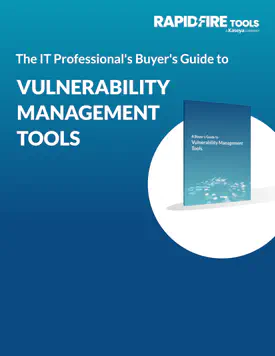Businesses that don’t identify and remediate vulnerabilities in their IT environments are easy targets for cybercriminals or malicious insiders. Given today’s cyberthreat landscape, not running vulnerability scans regularly is a mistake that, sooner or later, will cost your organization dearly.
Let’s take a few minutes to review what you need to know about vulnerability scanning. Read on to find out how your business can undertake vulnerability scanning without taxing your two most precious resources — time and money.
WHAT IS VULNERABILITY SCANNING?
Vulnerability scanning is a process that involves identifying network, application, and security vulnerabilities in an IT environment. Typically, it’s either an organization’s IT department or an external security service provider — such as a managed security service provider (MSSP) — that performs a vulnerability scan.
The process is carried out using a vulnerability scanning tool. The tool inspects an attack surface, identifies vulnerabilities, classifies them using a database of known vulnerabilities, and often predicts the effectiveness of existing countermeasures.
Vulnerability scans help businesses test security readiness and minimize risk, restricting the pathways hackers exploit to get unauthorized access. It’s no different from anticipating how a thief might enter your home. The point is to ensure you secure all possible entry points.
Cybersecurity vulnerabilities make your network susceptible to a range of cyberthreats, from ransomware to account takeovers. The bottom line? You absolutely need vulnerability scanning.
The U.S. government’s National Vulnerability Database (NVD), which is based on the Common Vulnerabilities and Exposures (CVE) list, currently has over 150,000 entries. Your business needs vulnerability scanning to ensure cyberattackers do not gain access to sensitive data using any one of these vulnerabilities.
Almost 22,000 vulnerabilities were published in 2021 alone — significantly higher than the number published in previous years (18,362 in 2020, 17,382 in 2019 and 17,252 in 2018). Nearly every cybersecurity statistic points out how crucial it is to harden your business’s cyber defenses ASAP. Before you invest thousands of dollars in security solutions, you should invest in building a comprehensive vulnerability scanning strategy.
WHAT IS THE DIFFERENCE BETWEEN VULNERABILITY SCANNING AND PENETRATION TESTING?
Vulnerability scanning and penetration testing are often mistaken as the same thing, but they are not. While a vulnerability scan is typically an automated test run using a tool aimed at unearthing potential security vulnerabilities, a penetration test involves a person running a comprehensive test of a network to exploit the weaknesses.
A vulnerability scan identifies and classifies vulnerabilities, but a penetration test gathers extensive data on the root cause of a vulnerability. Moreover, a pen tester might be able to help you with details on certain vulnerabilities that may be overlooked by a vulnerability scan.
Regular vulnerability scans can give you timely insights into your network security. However, there are times when you may need a more comprehensive analysis of your network security. That’s when you turn to a penetration test. Both vulnerability scans and penetration tests can help your business strengthen its cybersecurity immensely.
HOW DOES VULNERABILITY SCANNING WORK?
A vulnerability scanner only scans what you configure it for. Depending on the type of scan needed, the tool scans specific interfaces to invoke a response from the targeted devices. For example, if you’ve configured a vulnerability scan to detect outdated operating system versions in your network, the scanner will test the network devices accordingly. Once a device is detected to be running on an outdated operating system (such as Windows XP), the scanner will flag it as a vulnerability.
After identifying a vulnerability, the tool then matches the results against a database of vulnerabilities to classify the vulnerability and assign a risk rating to it. In the end, the scanner generates a report that can be analyzed and interpreted.
You can configure vulnerability scanners to scan all network ports and detect and identify password breaches and suspicious applications or services. It can help you manage security fixes or missing service packs, malware, coding flaws and remote access.
RapidFire Tools’ network vulnerability scanning solution, VulScan, is purpose-built for both MSPs and IT pros that manage IT security. It has all the bells and whistles you need for both internal and external vulnerability management. VulScan even includes an optional portable scanner that you can tote from one location to another for running ad-hoc scans without using consuming additional licenses. Most importantly, VulScan allows you to scan as many assets as you want, as often as you want.
Schedule a demo of VulScan now to get a first-hand look at why it is the most complete, automated and affordably priced vulnerability management solution available.
